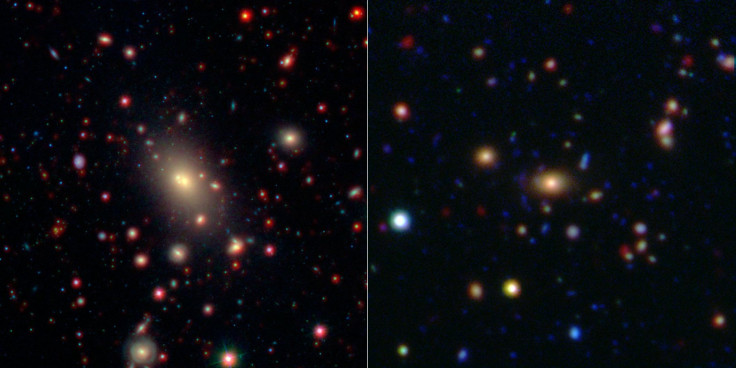‘Monster Galaxy’ In Galaxy Cluster Cannibalizes Others But Eventually Loses Taste For Galactic Blood
Galaxies can form galaxy clusters, a group of galaxies held together by gravity, similar to stellar clusters. At the center of a galaxy cluster is one galaxy that is much larger than the others and this “monster galaxy” engages in a form of cannibalism, devouring smaller galaxies and becoming much larger in the process.

As NASA reports, galactic cannibalism is thought to be a natural consequence of these galaxy clusters. Galaxies that are not associated with a cluster can collide and merge with other galaxies and in a densely packed area that process is expected to occur more frequently. Astronomers observing two galaxy clusters discovered the larger galaxy at the center of these clusters eventually stop consuming other galaxies but are unsure as to why this was the case.
Astronomers used data collected by NASA's Spitzer Space Telescope and Wide-field Infrared Survey Explorer (WISE), to observe 300 different galaxy clusters that covered 9 billion years of the universe’s history. Some of these galaxies date as far back to when the universe was just four billion years of age. According to NASA, Spitzer can observe galaxies in infrared light in great detail while WISE, which completed its observations of the universe in 2011, is better at observing distant galaxies.
Galaxy clusters could contain thousands of galaxies in a rather condensed plot of universal real estate and the center of these clusters is the brightest cluster galaxy (BCG). The BCG is an incredibly massive galaxy, NASA notes these galaxies can have a mass more than 12 times that of the Milky Way, and grow in size through galactic cannibalism. BCGs collide with other galaxies within the cluster and absorb other stars to become larger.
Led by Yen-Ting Lin, from the Academia Sinica in Taipei, Taiwan, the researchers created a consensus of galactic growth to chart the size of galaxies over billions of years, reports NASA. Lin said, “Our new approach allows us to connect the average properties of clusters we observe in the relatively recent past with ones we observe further back in the history of the universe.”
Based on these observations, the astronomers concluded the current models of galaxy growth need to be revised. According to Lin, the galaxies stopped growing about five billion years ago and there is no explanation as to why BCGs stopped cannibalizing other galaxies. Lin likens BCGs to blue whales, noting their size and rarity. “Our census of the population of BCGs is in a way similar to measuring how the whales gain their weight as they age. In our case, the whales aren't gaining as much weight as we thought,” Lin said.
More research is needed to explain this phenomenon but the researchers believe there may be one possible explanation. Galaxy clusters, and galactic collisions, could propel large stars away from the galaxy and the researchers hypothesize WISE or Spitzer are missing these stars in older galaxy clusters.
© Copyright IBTimes 2024. All rights reserved.






















